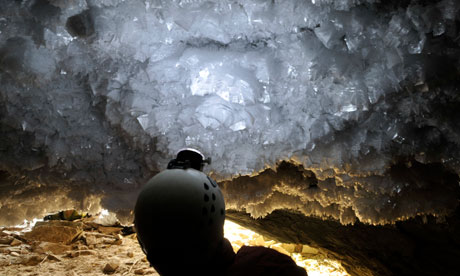
Foto de Vladimir V Alexioglo
O “permafrost”, solo permanentemente congelado do Ártico, pode começar a derreter daqui a entre 10 e 30 anos, liberando gases de efeito estufa na atmosfera e agravando o aquecimento global, indica um estudo publicado nesta quarta-feira. Matéria da AFP, no Yahoo Notícias, com informações adicionais do EcoDebate.
O permafrost poderia começar a derreter a partir de uma elevação das temperaturas globais de 1,5°C, em comparação com níveis pré-industriais, antecipa este estudo realizado a partir de estalagmites antigas.
A temperatura global média já aumentou 0,8º Celsius após a Revolução Industrial e se a tendência atual se mantiver, limite poderá ser alcançando de “10 a 30 anos”, calcula a equipe chefiada por Gideon Henderson, do Departamento de Ciências da Terra na Universidade de Oxford, na Grã-Bretanha.
“É necessário fazer um esforço urgente para reduzir os gases de efeito estufa”, alertaram os cientistas, que realizaram o estudo sobre estalagmites e estalagmites encontradas em uma gruta perto de Lensk, no leste da Sibéria.
Estes espeleotemas se formam quando a água da superfície se infiltra no teto da gruta, onde a temperatura ambiente é a mesma da superfície. Por isso, são testemunhos preciosos de uma época em que a região não era congelada.
Graças a vestígios de urânio e isótopos de chumbo, foi possível estabelecer que eles se formaram, em média, há 945.000 anos, depois novamente há 400 mil anos.
Estes períodos de degelo do permafrost coincidem com os períodos em que a superfície da Terra era 1,5ºC mais quente do que a era pré-industrial, com uma margem de erro de 0,5°C, indicam os cientistas.
O estudo deve ser apresentado em 27 de junho, indicou a instituição em um comunicado.
Também chamado de “pergelissolo”, o permafrost representa, em média, um quarto da superfície das terras no hemisfério norte. Em nível mundial, encerra 1,7 trilhão de toneladas de carbono, ou seja, cerca do dobro do CO2 já presente na atmosfera.
Se esta matéria orgânica congelada derreter, ela liberará lentamente todo o carbono acumulado e “neutralizado” com o passar dos séculos.
Este excesso de devolvido à atmosfera não foi até agora levado em conta nas projeções sobre o aquecimento global que são objeto de negociações em nível mundial.
A comunidade internacional se colocou como meta limitar o aquecimento a 2°C e conseguir alcançar um acordo global e ambicioso de limitação dos gases-estufa em 2015 durante a conferência climática da ONU prevista para ser celebrada em Paris.
De outra forma, as ações realizadas até o presente colocam o planeta numa trajetória de 3ºC a 5°C.
Siberian caves warn of permafrost meltdown
quarta-feira, 19 de junho de 2013 Geological Society of London, The
quarta-feira, 19 de junho de 2013 Geological Society of London, The
Climate records captured in Siberian caves suggest 1.5 degrees of warming is enough to trigger thawing of permafrost, according to a paper to be given at the Geological Society of London on 27 June.
Permafrost regions cover 24% of the northern hemisphere land surface, and hold an estimated 17,000 Gt of organic carbon. Thawing releases CO2 and CH4, creating positive feedback during greenhouse warming.
The researchers, led by Gideon Henderson at the University of Oxford’s Department of Earth Sciences, studied speleothem records from the caves to identify periods where temperatures were above freezing. Speleothems, such as stalactites and stalagmites, form when water seeps through cracks in cave walls, dissolving minerals which precipitate in the air filled cave.
‘Cave temperatures usually approximate the local mean annual air temperature’ says Anton Vaks, the paper’s lead author. ‘When they drop below 0 degrees, the rock above and around the cave freezes, and speleothem growth stops.’
By dating the speleothems and comparing their ages to existing climate records, it is possible to identify the degree of warming which caused the permafrost to melt. New results from Ledyanaya Lenskaya Cave, Eastern Siberia, extend previous records to one million years, and show major deposition of speleothems at around one million years and 400,000 years ago.
‘Both episodes occurred when global temperatures increased 1.5°C ± 0.5 above the pre-industrial level’ says Vaks, ‘showing that this degree of warming is a tipping point for continuous permafrost to start thawing.’
Global temperatures are currently around 0.7 degrees above pre-industrial level, with current models suggesting that a warming of 1.5°C ± 0.5 will be achieved within 10-30 years.
The paper will be read at the Geological Society’s forthcoming William Smith Meeting, held on 25-27 June, which celebrates the 100th anniversary of the beginning of modern dating methods.
In 1913, Frederick Soddy’s research on the fundamentals of radioactivity led to the discovery of ‘isotopes’. Later that same year, Arthur Holmes published his now famous book ‘The Age of the Earth’, in which he applied this new science of radioactivity to the quantification of geologic time. Combined, these two landmark events did much to establish the field of ‘isotope geochronology’ – the science that underpins our knowledge of the absolute age of most Earth and extraterrestrial materials.
The meeting will celebrate the anniversary of these scientific landmarks, as well as discussing the latest research and application of geochronological dating, including dating the early differentiation of planets, the dating of Lunar and Martian samples, and dating periods of environmental change.
For more information, visit: http://www.geolsoc.org.uk/wsmith13
Nenhum comentário:
Postar um comentário